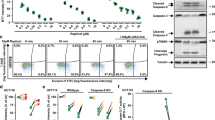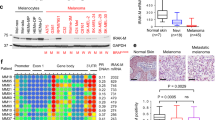Abstract
We have previously shown that Smac/DIABLO release from mitochondria appears to be the principal pathway by which TRAIL induces apoptosis of human melanoma. We report that TRAIL-induced release of Smac/DIABLO appears to be downregulated by concomitant signaling through the MEK Erk1/2 kinase pathway and that this inhibits TRAIL-induced apoptosis. Inhibition of Erk1/2 signaling by either the MEK inhibitor U0126 or a dominant-negative mutant of MKK1 markedly sensitized melanoma cells to TRAIL-induced apoptosis. The site in the apoptotic pathway acted on by U0126 appeared to be downstream of caspase-8 and Bid but upstream of caspase-3 in that the levels of proteolytic cleavage of caspase-8 and Bid by TRAIL were similar in cells with or without exposure to U0126. Caspase-3 activation and cleavage of its substrates, PARP, ICAD and XIAP, were however increased by cotreatment with U0126. This was associated with a rapid reduction in mitochondrial transmembrane potential (MMP) and increased release of Smac/DIABLO into the cytosol. Exploration of events leading to the changes in MMP revealed an increased translocation of Bax from the cytosol to mitochondria in the presence of U0126. There was also a delayed decrease in the levels of expression of Mcl-1. Bcl-2 and Bcl-XL. Over expression of Bcl-2 blocked TRAIL-induced apoptosis in the presence of U0126. Cytochrome c appeared not to play a major role in sensitization of melanoma to TRAIL in that caspase-9 activation was not detected in most of the cell lines. These results suggest that Erk1/2 signaling may protect melanoma cells against TRAIL-induced apoptosis by inhibiting the relocation of Bax from the cytosol to mitochondria and that this may reduce TRAIL-mediated release of Smac/DIABLO and induction of apoptosis.
This is a preview of subscription content, access via your institution
Access options
Subscribe to this journal
Receive 50 print issues and online access
$259.00 per year
only $5.18 per issue
Buy this article
- Purchase on Springer Link
- Instant access to full article PDF
Prices may be subject to local taxes which are calculated during checkout







Similar content being viewed by others
References
Adams JM and Cory S . (1998). Science, 281, 1322–1326.
Ashkenazi A, Pai RC, Fong S, Leung S, Lawrence DA, Marsters SA, Blackie C, Chang L, McMurtrey AE, Hebert A, DeForge L, Koumenis IL, Lewis D, Harris L, Bussiere J, Koeppen H, Shahrokh Z and Schwall RH . (1999). J. Clin. Invest., 104, 155–162.
Bellosillo B, Villamor N, Lopez-Guillermo A, Marce S, Bosch F, Camp E, Montserrat E and Colomer D . (2002). Blood. 100, 1810–1816.
Boucher M-J, Morisset J, Vachon PH, Reed JC, Laine J and Rivard N . (2000). J. Cell Biol., 79, 355–369.
Bouillet P and Strasser A . (2002). J. Cell Sci., 115, 1567–1574.
Burn TF and el-Deiry WS . (2001). J. Biol. Chem., 2, 37879–37886.
Cheng EH, Wei MC, Weiler S, Flavell RA, Mak TW, Lindsten T and Korsmeyer SJ . (2001). Mol. Cell., 8, 705–711.
Cross TG, Scheel-Toellner D, Henriquez NV, Deacon E, Salmon M and Lord JM . (2000). Exp. Cell Res., 256, 34–41.
Dai Y, Yu C, Singh V, Tang L, Wang Z, McInistry R, Dent P and Grant S . (2001). Cancer Res., 61, 5106–5115.
Degli-Esposti MA, Dougall WC, Smolak PJ, Waugh JY, Smith CA and Goodwin RG . (1997). Immunity. 7, 813–820.
Deng Y, Lin Y and Wu X . (2001). Genes Dev., 16, 33–45.
Desagher S, Osen-Sand A, Nichols A, Esker R, Montessuit S, Lauper S, Maundre K, Antunsson B and Marlinov JC . (1999). J. Cell. Biol., 144, 891–901.
Dhawan P and Richmond A . (2002). J. Biol. Chem., 277, 7920–7928.
Franco AV, Zhang XD, Van Berkel E, Sanders JE, Zhang XI, Thomas WD, Nguyen T and Hersey P . (2001). J. Immunol., 166, 5337–5345.
Ganju N and Eastman A . (2002). Biochem. Biophys. Res. Commun., 291, 1258–1264.
Gliniak B and Le T . (1999). Cancer Res., 59, 6153–6158.
Griffith TS, Chin WA, Jackson GC, Lynch DH and Kubin MZ . (1998). J. Immunol., 161, 2833–2840.
Griffith TS and Lynch DH . (1998). Curr. Opin. Immunol., 10, 559–563.
Hofmann K, Bucher P and Tschopp J . (1997). Trends Biochem. Sci., 22, 155–156.
Holmstrom TH, Tran SEF, Johnson VL, Ahn NG, Chow SC and Eriksson JE . (1999). Mol. Cell. Biol., 19, 5991–6002.
Hsu YT and Youle RJ . (1998). J. Biol. Chem., 273, 10777–10783.
Korsmeyer SJ, Wei MC, Saito M, Weiler S, Oh KJ and Schlesinger PH . (2000). Cell Death Differ., 7, 1166–1173.
Lee FS, Hagler J, Chen ZJ and Maniatis T . (1997). Cell. 88, 213–222.
Liu X, Kim CN, Yang J, Jemmerson R and Wang X . (1996). Cell. 86, 145–157.
Milella M, Kornblau SM, Estrov Z, Carter BZ, Lapillonne H, Harris D, Konopleva M, Zhao S, Estey E and Andreeff M . (2001). J. Clin. Invest., 108, 851–859.
O'Connor L, Strasser A, O'Reilly LA, Hausmann G, Adams JM, Cory S and Huang DC . (1998). EMBO J., 17, 384–395.
Oda E, Ohki R, Murasawa H, Nemoto J, Shibue T, Yamashita T, Tokino T, Taniguchi T and Tanaka N . (2000). Science. 288, 1053–1058.
Ozoren N, Kim K, Burns TF, Dicker DT, Moscioni AD and El-Deiry WS . (2000). Cancer Res., 60, 6259–6265.
Pitti RM, Marsters SA, Ruppert S, Donahue CJ, Moore A and Ashkenazi A . (1996). J. Biol. Chem., 271, 12687–12690.
Puthalakath H and Strasser A . (2002). Cell Death Differ., 9, 505–512.
Sabol SL, Li R, Lee TY and Abdul-Khalek R . (1998). Biochem. Biophys. Res. Commun., 253, 151–158.
Scheid M and Duronio V . (1998). Proc. Natl. Acad. Sci. USA. 95, 7439–7444.
Shimizu S, Narita M and Tsujimoto Y . (1999). Nature. 399, 483–487.
Soengas MS, Capodieci P, Polsky D, Mora J, Esteller M, Opitz-Araya X, McCombie R, Herman JG, Gerald WL, Lazebnik YA, Cordon-Cardo C and Lowe SW . (2001). Nature. 409, 207–210.
Thomas W, Zhang XD, Franco A, Nguyen T and Hersey P . (1999). J. Immunol., 165, 5612–5620.
Tran SEF, Holmstrom TH, Ahonen M, Kahari V-M and Eriksson JE . (2001). J. Biol. Chem., 276, 16484–16490.
von Hafen C, Wieder T, Gillissen B, Starck L, Graupner V, Dorken B and Daniel PT . (2002). Oncogene. 21, 4009–4019.
Walczak H, Degli-Esposti MA, Johnson RS, Smolak PJ, Waugh JY, Boiani N, Timour MS, Gerhart MJ, Schooley KA, Smith CA, Goodwin RG and Rauch CT . (1997). EMBO J., 16, 5386–5397.
Walczak H, Miller RE, Ariail K, Gliniak B, Griffith TS, Kubin M, Chin W, Jones J, Woodward A, Le T, Smith C, Smolak P, Goodwin RG, Rauch CT, Schuh JCL and Lynch DH . (1999). Nat. Med., 5, 157–163.
Wiley SR, Schooley K, Smolak PJ, Din WS, Huang C-P, Nicholl JK, Sutherland GR, Smith TD, Rauch C, Smith CA and Goodwin RG . (1995). Immunity, 3, 673–682.
Zha J, Harada H, Yang E, Jockel J and Korsmeyer SJ . (1996). Cell. 87, 619–628.
Zhang XD, Franco A, Myers K, Gray C, Nguyen T and Hersey P . (1999). Cancer Res., 59, 2747–2753.
Zhang XD, Zhang XI, Gray CP, Nguyen T and Hersey P . (2001). Cancer Res., 61, 7339–7348.
Acknowledgements
We thank Christine Cook for her excellent secretarial work. Suppored by the Melanoma and Skin Cancer Research Institute, Sydney, New South Wales, the Hunter Melanoma Foundation, Newcastle, New South Wales, and the New South Wales State Cancer Council, New South Wales, Australia.
Author information
Authors and Affiliations
Corresponding author
Rights and permissions
About this article
Cite this article
Zhang, X., Borrow, J., Zhang, X. et al. Activation of ERK1/2 protects melanoma cells from TRAIL-induced apoptosis by inhibiting Smac/DIABLO release from mitochondria. Oncogene 22, 2869–2881 (2003). https://doi.org/10.1038/sj.onc.1206427
Received:
Revised:
Accepted:
Published:
Issue Date:
DOI: https://doi.org/10.1038/sj.onc.1206427
Keywords
This article is cited by
-
Apoptotic proteins with non-apoptotic activity: expression and function in cancer
Apoptosis (2023)
-
Etlingera elatior Extract promotes cell death in B16 melanoma cells via down-regulation of ERK and Akt signaling pathways
BMC Complementary and Alternative Medicine (2017)
-
hvTRA, a novel TRAIL receptor agonist, induces apoptosis and sustained growth retardation in melanoma
Cell Death Discovery (2016)
-
Determinants of eosinophil survival and apoptotic cell death
Apoptosis (2015)
-
Synergistic anti-tumor activity and inhibition of angiogenesis by cotargeting of oncogenic and death receptor pathways in human melanoma
Cell Death & Disease (2014)



